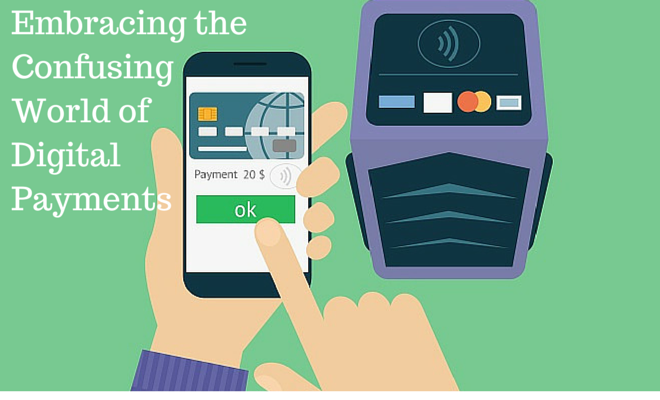
In September 2014, Apple made headlines when it introduced Apple Pay, the company’s entry into a crowded market of competing technologies vying to become the standard for mobile digital payments in the United States. Even with a growing list of retailers accepting this as a form of payment to help the technology go mainstream, the jury is still out on whether Americans and major retailers are ready to embrace it.
Over the last few weeks I decided to give mobile payments a try. I switched to Android last summer, but Google has a competing solution called Google Wallet that uses the same type of technology as Apple’s near-field communication or NFC. A little-mentioned fact is that any payment terminal that accepts Apple Pay also accepts Google Wallet, so Android users can also pay with their phones.
My favorite local grocer Wegmans was early to announce the adoption of NFC at their checkout counters. To try it out, I went through the self-serve checkout, swiped my items and when it came time to pay I pulled out my Android phone, where I already had Google Wallet set up. I placed it against the terminal and a second later a blue light indicated my transaction was complete. It couldn’t have been easier!
Since it was so easy for a customer, I decided to ask employees what they had to say about it. A manager mentioned she had only seen one other person do it in the last few months. Not surprising considering current estimates put Apple Pay use at only 6% of iPhone 6 and 6 Plus users despite its highly hyped roll-out. Google Wallet has received little to no publicity in comparison and despite projections for large future adoption, current mobile payment usage is still small.
Just how far away is a future where mobile payments are widespread? Another little-known fact is that all retailers in the United States will be replacing their terminals in the near future and most will likely opt to include technology like NFC when they do. The United States is moving over to EMV (Europay, MasterCard, and Visa) or what is referred to as Chip and PIN in Europe. It is a more secure, globally recognized form of payment that relies on a microchip to generate a unique code with each transaction rather than a fixed magnetic strip currently found in credit cards.
It will require consumers to enter a PIN code for each transaction. New terminals will need to be available at retailers and new cards issued by financial institutions. Universal roll-out will likely continue in the US through the end of the decade.
Companies like Apple and Google didn’t start releasing their new systems at this time by happenstance. The mandate for new technology and the coming change in consumer behavior made this a perfect time to try and disrupt the way we interact with the pay terminal. It was going to be disrupted anyway.
Why do so many people want you to pay by phone?
There are nuanced differences between Apple Pay, Google Wallet and other competitors. These systems act as a technology layer between your credit card and the retailer and ensure that your credit card number isn’t revealed to retailers.
Google acts as an intermediary, saving card data on their servers and then issuing a virtual card to your device for each transaction. There is no cost to the consumer, retailer or bank and the service tries to be a wallet replacement, storing loyalty cards and offering other incentives to consumers who make the switch.
Like all things Google, the company will likely find ways to use the information it stores about you and won’t share with retailers to make money for itself, likely by feeding its databases with information that can bulk up its products and services and selling that data to advertisers and marketers through its ad platforms.
Apple on the other hand works directly with banks, generating a token unique to that device and card (Device Account Number or DAN) that is sent on to a retailer when a transaction is made. This will keep the data flowing in to banks in exchange for providing security features (touch ID) and the means for consumers to make mobile purchases. So while Google continues to be a data company through Wallet, it would appear Apple is dipping a toe into the financial services industry.
Meanwhile, retailers Wal-Mart, Best Buy, CVS, Rite-Aid and others have formed a consortium called Merchant Customer Exchange or MCX and are backing a competitor to both systems called CurrentC that uses QR codes instead of NFC to make mobile payments. Their goal is to keep the data in house along with the 2%-3% in fees that credit card companies typically charge them per transaction. This system does not use credit cards and relies instead on a consumer’s debit card.
You would think that if any technology were likely to take a lead, it would be the one now installed on millions of iPhones and Android devices. Several people in the office have recently upgraded to an iPhone6, but none have utilized the Apple Pay feature. Knowing the percentage of people who use the service is low, it will be interesting to see if concessions or incentives are made by Apple, Google, or others to make mobile payments a more widely utilized form of payment by customers.
{{cta(‘d245f012-10d4-4c3c-982f-8e459ac722ee’)}}









